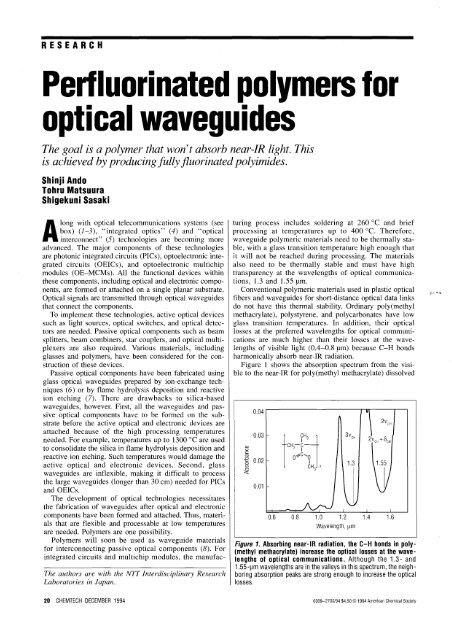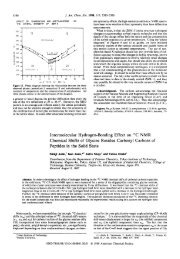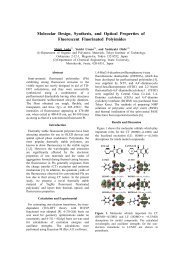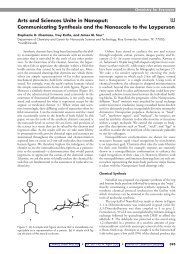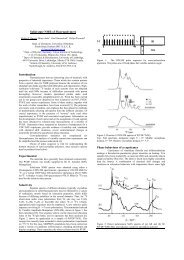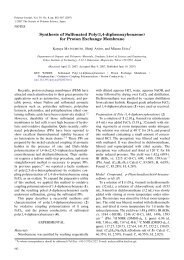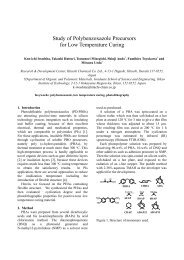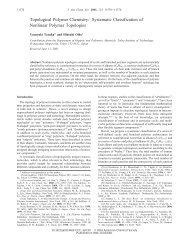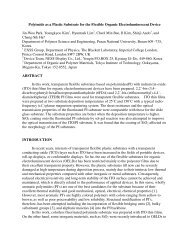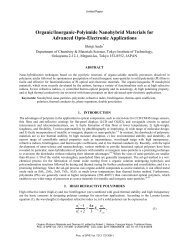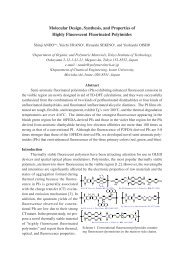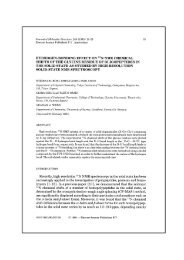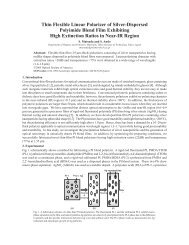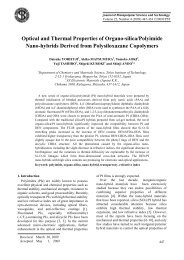Perfluorinated polymers for optical waveguides
Perfluorinated polymers for optical waveguides
Perfluorinated polymers for optical waveguides
Create successful ePaper yourself
Turn your PDF publications into a flip-book with our unique Google optimized e-Paper software.
RESEARCH<br />
<strong>Perfluorinated</strong> <strong>polymers</strong> <strong>for</strong><br />
<strong>optical</strong> <strong>waveguides</strong><br />
The goal is a polymer that won't absorb near-IR light. This<br />
is achieved by producing fully fluorinated polyimides.<br />
Shinji Ando<br />
Tohru Matsuura<br />
Shigekuni Sasaki<br />
A<br />
long with <strong>optical</strong> telecommunications systems (see<br />
box) (1-3), "integrated optics" (4) and "<strong>optical</strong><br />
interconnect" (5) technologies are becoming more<br />
advanced. The major components of these technologies<br />
are photonic integrated circuits (PICs), optoelectronic integrated<br />
circuits (OEICs), and optoelectronic multichip<br />
modules (OE-MCMs). All the functional devices within<br />
these components, including <strong>optical</strong> and electronic components,<br />
are <strong>for</strong>med or attached on a single planar substrate.<br />
Optical signals are transmitted through <strong>optical</strong> <strong>waveguides</strong><br />
that connect the components.<br />
To implement these technologies, active <strong>optical</strong> devices<br />
such as light sources, <strong>optical</strong> switches, and <strong>optical</strong> detectors<br />
are needed. Passive <strong>optical</strong> components such as beam<br />
splitters, beam combiners, star couplers, and <strong>optical</strong> multiplexers<br />
are also required. Various materials, including<br />
glasses and <strong>polymers</strong>, have been considered <strong>for</strong> the construction<br />
of these devices.<br />
Passive <strong>optical</strong> components have been fabricated using<br />
glass <strong>optical</strong> <strong>waveguides</strong> prepared by ion-exchange techniques<br />
(6) or by flame hydrolysis deposition and reactive<br />
ion etching (7). There are drawbacks to silica-based<br />
<strong>waveguides</strong>, however. First, all the <strong>waveguides</strong> and passive<br />
<strong>optical</strong> components have to be <strong>for</strong>med on the substrate<br />
be<strong>for</strong>e the active <strong>optical</strong> and electronic devices are<br />
attached because of the high processing temperatures<br />
needed. For example, temperatures up to 1300 °C are used<br />
to consolidate the silica in flame hydrolysis deposition and<br />
reactive ion etching. Such temperatures would damage the<br />
active <strong>optical</strong> and electronic devices. Second, glass<br />
<strong>waveguides</strong> are inflexible, making it difficult to process<br />
the large <strong>waveguides</strong> (longer than 30 cm) needed <strong>for</strong> PICs<br />
and OEICs.<br />
The development of <strong>optical</strong> technologies necessitates<br />
the fabrication of <strong>waveguides</strong> after <strong>optical</strong> and electronic<br />
components have been <strong>for</strong>med and attached. Thus, materials<br />
that are flexible and processable at low temperatures<br />
are needed. Polymers are one possibility.<br />
Polymers will soon be used as waveguide materials<br />
<strong>for</strong> interconnecting passive <strong>optical</strong> components (8). For<br />
integrated circuits and multichip modules, the manufac-<br />
The authors are with the NIT Interdisciplinary Research<br />
Laboratories in Japan.<br />
turing process includes soldering at 260°C and brief<br />
processing at temperatures up to 400 °C. There<strong>for</strong>e,<br />
waveguide polymeric materials need to be thermally stable,<br />
with a glass transition temperature high enough that<br />
it will not be reached during processing. The materials<br />
also need to be thermally stable and must have high<br />
transparency at the wavelengths of <strong>optical</strong> communications,<br />
1.3 and 1.55 rm.<br />
Conventional polymeric materials used in plastic <strong>optical</strong><br />
fibers and <strong>waveguides</strong> <strong>for</strong> short-distance <strong>optical</strong> data links<br />
do not have this thermal stability. Ordinary poly(methyl<br />
methacrylate), polystyrene, and polycarbonates have low<br />
glass transition temperatures. In addition, their <strong>optical</strong><br />
losses at the preferred wavelengths <strong>for</strong> <strong>optical</strong> communications<br />
are much higher than their losses at the wavelengths<br />
of visible light (0.4-0.8 rm) because C-H bonds<br />
harmonically absorb near-IR radiation.<br />
Figure 1 shows the absorption spectrum from the visible<br />
to the near-IR <strong>for</strong> poly(methyl methacrylate) dissolved<br />
'" '-'<br />
0.04<br />
0.03<br />
t<br />
I<br />
CH-C<br />
~t'q G~<br />
3v CH<br />
c<br />
.0 '"<br />
a 0.02<br />
1.3<br />
Cfl<br />
CH n<br />
.0<br />
3<br />
«<br />
0.01<br />
2VCH<br />
2VCH + °CH<br />
0.6 0.8 1.4 1.6<br />
Wavelength, ftm<br />
Figure 1. Absorbing near-IR radiation, the C-H bonds in poly<br />
(methyl methacrylate) increase the <strong>optical</strong> losses at the wavelengths<br />
of <strong>optical</strong> communications. Although the 1.3 - and<br />
1.55-~m wavelengths are in the valleys in this spectrum, the neighboring<br />
absorption peaks are strong enough to increase the <strong>optical</strong><br />
losses.<br />
20 CHEMTECH DECEMBER 1994<br />
0009-2703/94 $4.50 © 1994 American Chemical SOCiety
Telephone lines are carrying far more in<strong>for</strong>mation than they<br />
once did because of the increase in online computer communications<br />
and fax transmissions. Because <strong>optical</strong> fibers<br />
can carry so much more in<strong>for</strong>mation, they are replacing the<br />
copper in telephone wires. Instead of electricity, light in the<br />
near-IR part of the spectrum is transmitted through silicabased,<br />
single- mode <strong>optical</strong> fibers.<br />
For <strong>optical</strong> telecommunication systems, a wavelength of<br />
1.3 11m is best <strong>for</strong> the quality of transmission, allowing the<br />
least dispersion. The refractive index dispersion is zero at<br />
1.3 11m, and this wavelength is called the "zero-dispersion"<br />
wavelength <strong>for</strong> these fibers.<br />
However, this <strong>optical</strong> fiber has its minimum transmission<br />
loss at 1.55 11m. To transmit the signal at the highest speed<br />
with the least loss, the zero-dispersion wavelength and the<br />
minimum-loss wavelength should be identical.<br />
Techniques have been developed to shift the zero-dispersion<br />
wavelength of silica -based <strong>optical</strong> fibers to 1.55 11m (1).<br />
To confine the <strong>optical</strong> signal, the refractive index of the core<br />
of the fiber is made slightly higher than that of the cladding.<br />
A small amount of Ge0 2 is doped into the core of the silicabased<br />
fiber. Because this doping does not help to decrease<br />
the transmission loss, fluorine is doped into the cladding.<br />
The fluorine decreases the refractive index of the medium<br />
and inhibits water absorption.<br />
The transmission loss spectrum of such a dispersionshifted<br />
fiber shows that the lowest loss, 0.154 dB/km,<br />
occurs at 1.55 11m (2). This minimum loss is close to the<br />
theoretical limit determined from Rayleigh scattering and the<br />
harmonic absorption of oxygen-hydrogen (O-H) and silicon-oxygen<br />
(Si-O) bond stretching (3).<br />
The sharp absorption peak at 1.38 11m is due to the vibration<br />
of the residual Si-OH groups by the second harmonic of<br />
O-H bond stretching. The <strong>optical</strong> communication wavelengths<br />
of 1.3 and 1.55 11m are located in the valleys between<br />
the absorption peaks, indicating the low transmission losses<br />
Optical telecommunications<br />
at these wavelengths. As a result of the research developments<br />
with silica-based <strong>optical</strong> fibers, the transmission<br />
wavelength will soon be shifted from 1.3 to 1.55 11m in the<br />
<strong>optical</strong> telecommunication systems in Japan.<br />
E<br />
""" co<br />
1.0<br />
-0 0.5<br />
and 6FDA and PMDA as the dianhydrides.<br />
o 0<br />
II<br />
II<br />
o~C~C~O<br />
c~c<br />
II<br />
II<br />
o 0<br />
Increasing the PMDA ratio made the refractive index of<br />
the core slightly higher than that of the cladding.<br />
In the fabrication process, an undercladding layer and a<br />
core layer of the polyimide are <strong>for</strong>med on a substrate (Figure<br />
3). The undercladding is <strong>for</strong>med by spin coating of the<br />
substrate with poly(amic acid) solution (a prepolymer<br />
solution of the anhydride and the diamine) followed by<br />
thermal imidization. The difference in refractive index<br />
between the core and the undercladding is about 0.4%.<br />
The core ridge is then fabricated by photolithographic patterning<br />
and reactive ion etching with the use of oxygen.<br />
Finally, an overcladding layer is <strong>for</strong>med.<br />
These fluorinated polyimide <strong>waveguides</strong> have <strong>optical</strong><br />
losses of
OJ<br />
'-'<br />
c:<br />
eO<br />
-2<br />
o<br />
.c '"<br />
Table 1. Molecular structure and properties of amorphous and semicrystalline perfluoro<strong>polymers</strong><br />
(/X(I" (Cf~f,+.-<br />
F F F F<br />
~rf+ --{Cf,-Cf+<br />
Property<br />
F3C CF3 F F<br />
TellonAF<br />
Morphology<br />
Amorphous<br />
Fluorine content, wt % 67.1,65.0<br />
Glass transition temp., °c<br />
160, 240 a<br />
Melting point, °c<br />
Dielectric constant 1.89-1.93<br />
Refractive index 1.29-1.31<br />
Optical transmittance, % >95<br />
(visible region)<br />
a The glass transition temperature with no TFE content is higher than 300°C.<br />
Cytop<br />
PTFE<br />
Amorphous<br />
Semicrystalline<br />
67.9 76.0<br />
108<br />
327<br />
2.1-2.2 2.1<br />
1.35 1.38<br />
95 Opaque<br />
We first determined the reactivIties of the diamines<br />
shown in Figure 6 by synthesizing poly(amic acid)s using<br />
6FDA as the dianhydride. Note that 6FDA is not perfluorinated.<br />
The end-group contents of the poly(amic acid)s that<br />
were determined from 19F NMR are as follows:<br />
• 4FMPD tetrafluoro-m-phenylenediamine 15%<br />
• 4FPPD tetrafluoro-p-phenylenediamine 42%<br />
• 8PODA<br />
bis(2,3,5,6~tetrafluoro-4-<br />
75%<br />
aminopheny 1 )ether<br />
• 8FSDA bis(2,3,5,6-tetrafluoro-4-<br />
91%<br />
aminophenyl)sulfide<br />
• 8FBZ 4,4'-diaminooctofluorobiphenyl >99%<br />
Of these, 4FMPD shows the lowest end-group content, or<br />
the highest reactivity, and 4FPPD shows the next lowest<br />
end-group content.<br />
However, <strong>for</strong> all the diamines, the acylations were not<br />
complete, and end-group contents were still high even<br />
after 6 days of reaction at room temperature. When 8FBZ<br />
diamine, the least reactive one, was reacted with 6FDA, no<br />
NMR signal <strong>for</strong> the poly(amic acid) was detected. The<br />
electron-donating properties of the diamines, which determine<br />
the reactivity of diamines <strong>for</strong> acylation, matched the<br />
end-group contents of the poly(amic acid)s (20). We estimated<br />
the electron-donating properties from 15N NMR<br />
chemical shifts and from electron-related parameters such<br />
as ionization potential, electronic affinity, and molecular<br />
orbital energy.<br />
However, Hougham and co-workers at IBM have prepared<br />
continuous films using 6FDA as the dianhydride and<br />
4FPPD and 8FBZ as diamines (22). They showed that two<br />
Figure 6. These structures are used to<br />
synthesize perfluorinated polyimides.<br />
This perfluorinated dianhydride and the five<br />
perfluorinated diamines may be purchased<br />
or prepared by known procedures.<br />
F<br />
F F<br />
F<br />
4FPPD<br />
4FMPD<br />
F<br />
F F<br />
BFBZ<br />
F<br />
""*S*'"' ""*0*'",<br />
F F F F F F F F<br />
BFSDA<br />
BFODA<br />
24 CHEMTECH DECEMBER 1994
~ .... ',I;<br />
stages of polymerization are needed to obtain high molecular<br />
weight polyimides from the perfluorinated diamines:<br />
a solution polycondensation at temperatures of 130 °c_<br />
150°C followed by a high-temperature, solid state chain<br />
extension.<br />
A novel perfluorinated dianhydride is needed<br />
The introduction of fluorine or fluorinated groups into<br />
dianhydrides increases their reactivity. The 13C NMR<br />
chemical shift of carbonyl carbons (oC) of P6FDA suggests<br />
a considerable increase in reactivity (20). There<strong>for</strong>e,<br />
P6FDA should compensate <strong>for</strong> the low reactivity of perfluorinated<br />
diamines.<br />
However, the end-group content of the poly(amic acid)<br />
synthesized from 4FMPD and P6FDA was 36% (just<br />
higher than that from 4FMPD and 6FDA). Furthermore,<br />
the resultant perfluorinated polyimide P6FDA--4FMPD<br />
/ R*CF3 C 0 ~ \ N<br />
N /<br />
\ C<br />
C II F<br />
g CF3 0<br />
was cracked and brittle and did not <strong>for</strong>m a continuous<br />
film. For the other four diamines, the polyimides prepared<br />
with P6FDA were coarse powders or films that had many<br />
cracks.<br />
The main reason the films are not continuous is that the<br />
high reactivity of the perfluorinated dianhydride probably<br />
could not compensate <strong>for</strong> the low reactivities of perfluorinated<br />
diamines. However, the rigidity of the polymer<br />
chain cannot be neglected in the cases of P6FDA and onebenzene-ring<br />
diamines. In this situation, bond rotation is<br />
permitted only at the imide linkage (nitrogen aromatic<br />
carbon bond). However, this rotation is restricted by steric<br />
hindrance between the fluorine atoms and carbonyl oxygens.<br />
The rigidity of the polymer chain must be improved<br />
by the introduction of flexible linkage groups into the<br />
dianhydride component. Accordingly, we would expect to<br />
make continuous and flexible films of perfluorinated polyimides<br />
by combining diamines, which have high reactivities,<br />
with dianhydrides, which have flexible molecular<br />
structures.<br />
We synthesized a novel perfluorinated dianhydride, 1,4-<br />
bis (3 ,4-dicarboxytrifl uorophenox y )tetrafluoro benzene<br />
dianhydride (lOFEDA), as in the first three steps of the<br />
scheme in Figure 7. This molecule has two ether linkages<br />
that give flexibility to the molecular structure. In addition,<br />
the chemical shift of carbonyl carbons of lOFEDA was<br />
almost the same as that of P6FDA. There<strong>for</strong>e, this dianhydride<br />
should have a reactivity that is higher than those of<br />
unfluorinated and partially fluorinated dianhydrides.<br />
The end-group content of the poly(amic acid) prepared<br />
from lOFEDA and 4FMPD was 6%, which is much less<br />
than that of poly(amic acid) prepared from P6FDA and<br />
4FMPD (36%). This result can be attributed to the considerable<br />
increase in flexibility of the dianhydride structure.<br />
The resultant perfluorinated polyimide (lOFEDA-<br />
4FMPD) was a 9.5-).lm-thick, strong, flexible film that had<br />
a pale yellow color like DuPont's Kapton. The structure of<br />
the lOFEDA--4FMPD polyimide was confirmed by elemental<br />
analysis, IR spectroscopy, and 19F NMR (23).<br />
Figure 8 (p. 26) shows the visible-to-near-IR absorption<br />
F<br />
F<br />
F<br />
spectrum of lOFEDA--4FMPD, cured at 200°C and dissolved<br />
in acetone-d 6 (10 wt %). The same amount of acetone-d<br />
6 was used as a reference. The solid line indicates<br />
the absorbance of lOFEDA--4FMPD, and the dashed line<br />
indicates the absorbance of partially fluorinated polyimide<br />
(6FDA-TFDB).<br />
to F3C CF3 0<br />
II \ ! II<br />
N:)~)Cl~I)<br />
II<br />
II<br />
o 0 F3C<br />
F<br />
NC*F<br />
2 0<br />
NC F<br />
F<br />
TFPN<br />
F<br />
F<br />
+ HO*OH<br />
j Et3N<br />
in DMF<br />
F<br />
TFHQ<br />
NC*' o*o*F CN<br />
NC F F F F CN<br />
10FEDP<br />
! H2S04 aq.<br />
HOOC*' o*o*F COOH<br />
HOOC F F F F COOH<br />
F l~ F<br />
)*'<br />
FF<br />
o*o*F g,o<br />
,OF F 0 /<br />
R F F R<br />
o F 10FEOA F 0<br />
F<br />
N<br />
NH<br />
in DMAc + H2 * 2<br />
11* *111*1<br />
F<br />
F F<br />
OF * F OH F H<br />
COO 0 C-N N<br />
HOOC 0 F F F F 0 COOH F 0 F<br />
F 1 ~ F F<br />
)*'<br />
F F<br />
O*O*F g'N<br />
'c 0 F F 0 c'<br />
II F F II F<br />
OFF 0<br />
10FEOA/4FMPO<br />
Figure 7. This scheme shows the steps <strong>for</strong> synthesizing a new<br />
perfluorinated dianhydride, 10FEDA. From this anhydride, a poly<br />
(amic acid) is prepared from which the perfluorinated polyimide is<br />
derived.<br />
F<br />
F<br />
F<br />
CHEMTECH DECEMBER 1994 25
'" '-'<br />
c<br />
..c<br />
'"<br />
0<br />
(J)<br />
..c<br />
-0::<br />
0.04<br />
0.03<br />
0.01<br />
-10FEDN4FMPD<br />
$ 1 \<br />
2VCH~:~;<br />
6F::::~ 1 \<br />
2V$CH + O$CH<br />
3v$ -[ ~<br />
CH j\ ... ................................. .<br />
Table 2. Strengths and flexibilities of perfluorinated<br />
polyimide films<br />
Dianhydride<br />
Diamine 1DFEDA P6FDA<br />
4FPPD<br />
No film<br />
4FMPD Strong and flexible Brittle and cracked<br />
8FODA Flexible Nofilm<br />
8FSDA Flexible Nofilm<br />
8FBZ Nofilm Nofilm<br />
0.6 0.8 1.0 1.2 1.4 1.6<br />
Wavelength, 11m<br />
Figure 8. The perfluorinated polyimide 10FEDA-4FMPD does not<br />
have a substantial absorption peak over the wavelengths <strong>for</strong> <strong>optical</strong><br />
communication. However, the partially fluorinated polyimide<br />
6FDA-TFDB does have one. For 10FEDA-4FMPD, indicated by the<br />
solid line over the shaded area, the small peak at 1.4 ~m is caused<br />
by moisture, and the line below it shows what the absorbance<br />
would be without the moisture.<br />
Except <strong>for</strong> a small absorption peak at l.4).lm caused by<br />
moisture absorbed in the solvent or adsorbed onto the polyimide<br />
film, the perfluorinated polyimide has no substantial<br />
absorption peak over the wavelengths <strong>for</strong> <strong>optical</strong> communication.<br />
However, partially fluorinated polyimide has an<br />
absorption peak that arises from the third harmonic of the<br />
stretching vibration of the C-H bond (1.1 ).lm), a peak that<br />
results from the combination of the second harmonic of<br />
stretching vibration and the de<strong>for</strong>mation vibration of the<br />
C-H bond (1.4 ).lm), and a peak that is attributable to the<br />
second harmonic of the stretching vibration of the C-H<br />
bond (1.65 ).lm). In the visible spectrum, the electronic<br />
transition absorption of lOFEDA-4FMPD is slightly<br />
shifted to longer wavelengths than that of 6FDA-TFDB.<br />
This shift causes the yellowish color of lOFEDA-4FMPD<br />
but does not affect the transparency at near-IR wavelengths.<br />
Table 2 lists the strengths and flexibilities of perfluorinated<br />
polyimide films synthesized from the two dianhydrides<br />
and five diamines. Polymerizing lOFEDA with<br />
8FODA or 8FSDA produced continuous, flexible films,<br />
but the films are slightly brittle compared with lOFEDA-<br />
4FMPD. As already mentioned, P6FDA did not give any<br />
continuous films.<br />
The properties of perfluorinated polyimides, along with<br />
those of partially fluorinated and unfluorinated polyimides,<br />
are listed in Table 3. The structure of PMDA-ODA<br />
is the same as that of Kapton. Because the lOFEDA component<br />
has a flexible structure, the polymer decomposition<br />
temperatures and glass transition temperatures (Tgs) of<br />
perfluorinated polyimides are slightly lower than those of<br />
conventional polyimides. Nonetheless, the thermal stability<br />
of these films is considered high enough to be able to<br />
withstand the manufacture of integrated circuits and multichip<br />
modules.<br />
In addition, the direct introduction of fluorines into the<br />
aromatic rings does not cause a substantial increase in fluorine<br />
content. The adhesiveness of the perfluoropolyimides<br />
is thus equivalent to that of the partially fluorinated<br />
polyimides used to fabricate single-mode <strong>waveguides</strong>.<br />
Their dielectric constants (E) at 1 kHz and their average<br />
refractive indices are as low as those of the partially fluorinated<br />
polyimides. The reason <strong>for</strong> these similarities is that<br />
the fluorine content of perfluorinated polyimides is comparable<br />
to that of partially fluorinated polyimides.<br />
However, the birefringence of perfluorinated polyimides<br />
is lower than that of partially fluorinated polyimides. This<br />
difference is caused by the steric effect between perfluorinated<br />
aromatic rings and bent structures such as ether,<br />
thio-ether, and meta linkages. The low birefringence is<br />
convenient <strong>for</strong> designing waveguide structures in the interconnections<br />
of OEICs and multichip modules.<br />
The refractive indices of perfluorinated polyimides can<br />
be controlled by copolymerization in the same manner as<br />
those of partially fluorinated polyimides (14). These characteristics<br />
show that perfluorinated polyimides are promising<br />
materials <strong>for</strong> <strong>waveguides</strong> in integrated optics and<br />
<strong>optical</strong> interconnect technology.<br />
Table 3. Properties of perfluorinated polyimides, partially fluorinated polyimides, and unfluorinated polyimides<br />
Average<br />
Fluorine Decomposition Dielectric refractive Bir!!fringence,<br />
content, % temp.,oC Tg,oC constant, E index, Ii nTE-n TM<br />
10FEDA-4FMPD 36.6 501 309 2.8 1.562 0.004<br />
10FEDA-8FODA 38.4 485 300 2.6 1.552 0.004<br />
10FEDA-8FSDA 37.7 488 278 2.6 1.560 0.006<br />
10FEDA-TFDB 35.1 543 312 2.8 1.569 0.009<br />
6FDA-TFDB 31.3 553 327 2.8 1.548 0.006<br />
PMDA-TFDB 22.7 613 >400 3.2 1.608 0.136<br />
PMDA-ODA 0 608 >400 3.5 1.714 0.088<br />
26 CHEMTECH DECEMBER 1994
References<br />
(1) Cohen, L G,; Lin, c'; French, W G, Electron. Lett. 1979, 15, 334.<br />
(2) Yokota, H.; Kanamori, H.; Ishiguro, Y.; Shinba, H. Technical Digest<br />
of the Optical Fibers Conference' 86, Atlanta; Conference on Optical<br />
Fiber Communication, Washington, DC, 1986, post-deadline<br />
Paper 3.<br />
(3) Miya, T.; Terunuma, Y.; Hosaka, T.; Miyashita, T. Electron. Lett.<br />
1979, 15, 106.<br />
(4) Miller, S. E. Bell. Syst. Tech. J. 1969,48, 2059.<br />
(5) Goodman, J. W.; Leonberger, F. J.; Kung, S.; Athale, R Proc. IEEE<br />
1984, 72, 850.<br />
(6) Seki, M.; Sugawara, R.; Hashizume, H.; Okuda, E. Proceedings of<br />
the Optical Fibers Conference' 89, Houston, Conference on Optical<br />
Fiber Communication, Washington, DC, 1989, post-deadline Paper<br />
4.<br />
(7) Kawachi, M.; Kobayashi, M.; Miyashita, T. Proceedings of the<br />
European Conference on Optical Fiber Communication '87, Helsinki;<br />
The Consulting Committee of the Professional Electroengineers<br />
Organization, Helsinki, Finland, 1987, p. 53.<br />
(8) Kurokawa, T.; Takato, N.; Katayama, T. Appl. Opt. 1980,19,3124.<br />
(9) Furuya, K.; Miller, B. I.; Coldman, L A.; Howard, R. E. Electron.<br />
Lett. 1982, 18, 204.<br />
(10) Franke, H; Crow, J. D. "Integrated Optical Circuit Engineering III,"<br />
Kersten, R T., Ed.; Proc. SPIE 1986, 651, 102.<br />
(11) Sullivan, C. T. "Optoelectronic Materials, Devices, Packaging, and<br />
Interconnects II," McWright, G. M.; Wojtunik, H. J., Eds.; Proc.<br />
SPIE 1988, 994, 92.<br />
(12) Hagerhorst-Trewhella, J. M.; Gelome, J. D.; Fan, B.; Speth, A.; Flagello,<br />
D.; Oprysko, M. M. "Integrated Optics and Optoelectronics,"<br />
Wong, K.; Wojtunik, H. J.; Peng, S. T.; Mentzer, M. A.; McCaughan,<br />
L, Eds; Proc. SPIE 1990, 1177, 379.<br />
(13) Reuter, R; Franke, H.; Feger, C. Appl. Opt. 1988, 27, 4565.<br />
(14) Matsuura, T.; Ando, S.; Matsui, S.; Sasaki, S.; Yamamoto, S. Electron.<br />
Lett. 1993,29,2107.<br />
(15) Matsuura, T.; Hasuda, Y.; Nishi, S.; Yamada, N. Macromolecules<br />
1991,24,5001.<br />
(16) Kaino, T.; Fujiki, M.; Nara, S. 1. Appl. Phys. 1981, 52, 7061.<br />
(17) Kaino, T.; Jinguji, K.; Nara, S. Appl. Phys. Lett. 1983,42,567.<br />
(18) Imamura, S.; Yoshimura, R; Izawa, T. Electron. Lett. 1991, 27,<br />
1342.<br />
(19) Aosaki, K. Plastics (Japan) 1991,42,51.<br />
(20) Ando, S.; Matsuura, T.; Sasaki, S. In Polymers <strong>for</strong> Microelectronics,<br />
Resists, and Dielectrics; Thompson, L F.; Willson, C, G.; Tagawa,<br />
S., Eds.; ACS Symposium Series 537; American Chemical Society:<br />
Washington, DC, 1994; p. 304.<br />
(21) Bessonov, M. I.; Koton, M. M.; Kudryavtsev, V. Y.; Laius, L A.<br />
Polyimides, Thermally Stable Polymers; Consultants Bureau: New<br />
York, 1987; Chapter 2.<br />
(22) Hougham, G.; Tesoro, G.; Shaw, J. In Polyimides, Materials, Chemistry,<br />
and Characterization; Feger, c'; Khojasteh, M. M.; McGrath,<br />
J. E., Eds.; Elsevier Science Publishers: Amsterdam, 1989; p. 465.<br />
(23) Ando, S.; Matsuura, T.; Sasaki, S. Submitted <strong>for</strong> publication in<br />
Magn. Reson. Chem.<br />
Tohru Matsuura is a Research Scientist at<br />
NTT Interdisciplinary Research Laboratories,<br />
where he develops high-per<strong>for</strong>mance fluorinated<br />
polyimides <strong>for</strong> <strong>optical</strong> applications and<br />
fabricates <strong>optical</strong> waveguide circuits. He joined<br />
NTT Electrical Communications Laboratories in<br />
1986 and received his Ph.D. in Organic and<br />
Polymeric Materials from Tokyo Institute of<br />
Technology in 1993.<br />
Shinji Ando is a Research Scientist at Nippon<br />
Telegraph and Telephone Corporation (NTT<br />
Interdisciplinary Research Laboratories, Midoricho<br />
3-9-11, Musashino-shi, Toyko, 180 Japan;<br />
+81-422-59-3042, e-mail anshin@aela.ntt.jp).<br />
His research interests include the <strong>optical</strong> properties<br />
and electronic structure of fluorinated polyimides<br />
and <strong>optical</strong> components made from these<br />
materials. He received his Ph.D. in Polymer<br />
Chemistry at Tokyo Institute of Technology in<br />
1989 and has been with NTT ever since.<br />
Shigekuni Sasaki is Head of the Advanced<br />
Organic Materials Research group at NTT Interdisciplinary<br />
Research Laboratories. His group<br />
research focuses on the development of <strong>optical</strong><br />
fluorinated polyimides and their application to<br />
<strong>optical</strong> communication components. He joined<br />
NTT Electrical Communications Laboratories in<br />
1977 and received his Ph.D. in Applied Chemistry<br />
from Tokyo Institute of Technology in<br />
1991.<br />
EDUCATION: AN INDUSTRIAL IMPERATIVE<br />
Our educational system does not appear to be capable<br />
of producing persons with the flexibility necessary to<br />
deal with the changes that American industry feels are<br />
imperative if it is to be competitive. Neither does our<br />
educational system seem to be capable of undergoing<br />
the changes necessitated by today's societal pressures.<br />
Conventional wisdom currently holds that future<br />
workers should be able to acquire the flexibility necessary<br />
to respond to changing needs by learning new<br />
skills in an appropriate educational system. It's not as<br />
if the American educational system is lacking resources;<br />
rather, it appears that the system does not provide<br />
those elements of education that infuse students with<br />
the ability to learn new skills.<br />
J. J. Lagowski<br />
Editor, Journal of Chemical Education<br />
CHEMTECH DECEMBER 1994 27


